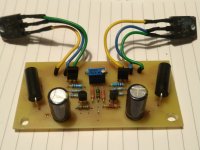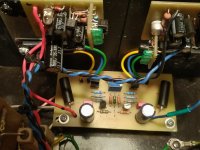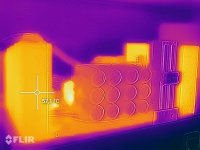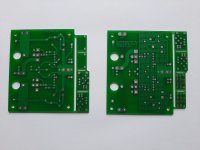Hey Dude!
This is not about a PCB. It is about how the curcuit works or doesnt.
We are all here to learn.
I dont know the Leach AMP.
I agree that in 95% of all power amps it is a good idea to isolate the input stage by an RC or LC. But not in the Monster.
Lets look at the upper half of the AMP:
The output stage (consisting of driver and power trans and the 1ohm resistor) can be considered as one gain block with one high impedance output and two inputs. The two inputs are: the top of the resistor and the base of the driver. The output stage will amplify any voltage difference between those two inputs.
Now imagine some dirt on the rail. If you filter the input rail, you will have dirt at one input but not at the other, and this dirt will be amplified by the output stage. On the other hand, if you dont filter the input rail, the same dirt will apear on both input and therefore not have much influence on the output signal.
So, in this case, filtering the power line to the input will be counter productive, if your goal is to increase power supply rejection.
Hope this helps, else someone else might be able to explain it more clearly.
If anyone is interested in this topic, check out John Broskis Aikido principle at tubecad.com, as he has written many pages about different ways to increase power supply rejection.
I can also referr to authority: If it was a good idea, His Holyness Jean Hiraga would have done it, but he didnt.
Best wishes
Thorsten
Thanks Thorsten, I realize you have right.
Today I shortened the inductors and did the final adjustment of the amplifier.
The bias in the output stage is now adjusted a bit higher at 903mA in the Left channel and 905mA in the Right channel.
Offset voltage is below 11mV.
All the figures is after 20min warmup time.
The sound is stunning, very tight and deep bass, almost holographic placement of voice and instruments and you can point out exactly where everything is placed in the soundstage.
No noise at all if you listen close to the speakers.
Bought Qacoustics Concept 500 speakers a few days ago.
Working perfect together and you can play really loud without any hardness in the sound.
After a while I found the soft bass plugs on the floor, behind the speakers, the air pressure had blown them out of the speakers.
The source I use is a Raspberry Pi 4b with AUDIOPHONICS DAC I-Sabre ES9038Q2M.
LibreElec OS (Kodi) with Airplay or high res. files on USB source.
Battery powered with a 5,1V / 3A custom voltage regulator.
Instead of Toshiba 2SC2705 / 2SA1145 yesterday I put NEC 2SC1940 / 2SA915 for driver transistors.
The amp now sounds even more open and cleaner, the bass is firmer and more accurately played, it has a kick.
I am pleased with the result considering that 2SC1941 proved to be excellent in JLH69. Today I will still try to boost the current through the output, now it is 1.3A and I will try around 1.8A.
The amp now sounds even more open and cleaner, the bass is firmer and more accurately played, it has a kick.
I am pleased with the result considering that 2SC1941 proved to be excellent in JLH69. Today I will still try to boost the current through the output, now it is 1.3A and I will try around 1.8A.
Attachments
Hi everyone, I haven't actively read diyaudio since 2014, & haven't actively posted anything since then either.
I saw this video on the Hiraga in youtube yesterday, it's pretty cool, enjoy~
Jean Hiraga super classA 30W amplifier build part 2 - YouTube
I saw this video on the Hiraga in youtube yesterday, it's pretty cool, enjoy~
Jean Hiraga super classA 30W amplifier build part 2 - YouTube
Le Monstre at +/- 18V, current 1.8A, sounds great.
The entire heat-sink section appears to be at 57.1° in his heat signature pic, hmm.. so without the heat-sinks, the Jean Hiraga Class-A is like what, 57.1° in all that steel is quite a lot of energy, so the same amount of energy in the amplifier PCB, resistors, capacitors, transistors etc etc is like.. 120°? (just guessing). This is a rare scenario where chips such as the OPA627SM are necessary (i.e. versus the 627AP) since the datasheet says the SM can handle -55° to 125° while the AP is recommended for use only up to 85°.
The aluminium(?) To-99.. additionally.. to some extent shield op-amps from Wi-Fi & radio & electromagnetic stuff.. (the datasheet talks about EMIRR as well). Hm, I am not sure how important all that is the tiny amount of noise, although you guys are really trying to achieve the "black background" & "complete silence" so you design the Aluminium chassis around the PCB in a way so the chassis catches all the RF & EMI & doesn't transfer it to the PCB right? I remember an experiment around a radio where you just put a device (like a net) on top of the radio then it blocks all the RF & the radio doesn't work anymore.
~
Anyway in summary, we will not be seeing a Jean Hiraga Class-A amplifier in a smartphone or portable music player. =P
In smartphones, the maximum audio quality will be, something around LME49720.
Last edited:
Kastor
I don't like at all the construction in the video. Furthermore the direction of the fins should be VERTICAL (for natural ventilation cooling).
I prefer 2 bridges for each amplifier (one for the positive rail + one for negative) + multiple parallel capacitors for each polarity rail (much higher surge current needed at, let say, 20Hz ).
The all metal case is A MUST for audio equipment (screening + heat dispersion) and NO FANS
I don't like at all the construction in the video. Furthermore the direction of the fins should be VERTICAL (for natural ventilation cooling).
I prefer 2 bridges for each amplifier (one for the positive rail + one for negative) + multiple parallel capacitors for each polarity rail (much higher surge current needed at, let say, 20Hz ).
The all metal case is A MUST for audio equipment (screening + heat dispersion) and NO FANS
Kastor
I don't like at all the construction in the video. Furthermore the direction of the fins should be VERTICAL (for natural ventilation cooling).
I prefer 2 bridges for each amplifier (one for the positive rail + one for negative) + multiple parallel capacitors for each polarity rail (much higher surge current needed at, let say, 20Hz ).
The all metal case is A MUST for audio equipment (screening + heat dispersion) and NO FANS
Yes, the heatsink is too small for 30W Hiraga and thus better if the fins are vertical. I think a small fan right on top of the transistor wont hurt (as long as it is quiet).
Surprisingly in many cases a metal case makes the sound worse.
But hey, this is a 8W Le Monstre thread (not the 20/30W).
Yes, the heatsink is too small for 30W Hiraga and thus better if the fins are vertical. I think a small fan right on top of the transistor wont hurt (as long as it is quiet).
Surprisingly in many cases a metal case makes the sound worse.
But hey, this is a 8W Le Monstre thread (not the 20/30W).
[QUOTE=johnego
I was referred to the amplifier in the video (follow the link in post 2068)
I was referred to the amplifier in the video (follow the link in post 2068)
Yes, yes, I know
Klaus Scherm in Germany has improved the design.
I think not.
I would like to try these if you ever get some made - add my name to a pair please. Thanks
Currently I use the original 8w design and use the original output transistors which were pulls from old devices.
There is a substantial sonic difference between the originals and todays "equivalents"
The best amp I have ever heard.
Currently I use the original 8w design and use the original output transistors which were pulls from old devices.
There is a substantial sonic difference between the originals and todays "equivalents"
The best amp I have ever heard.
- Home
- Amplifiers
- Solid State
- Hiraga "Le Monstre"




